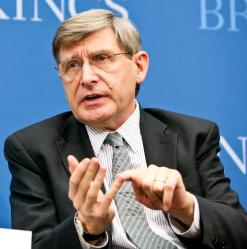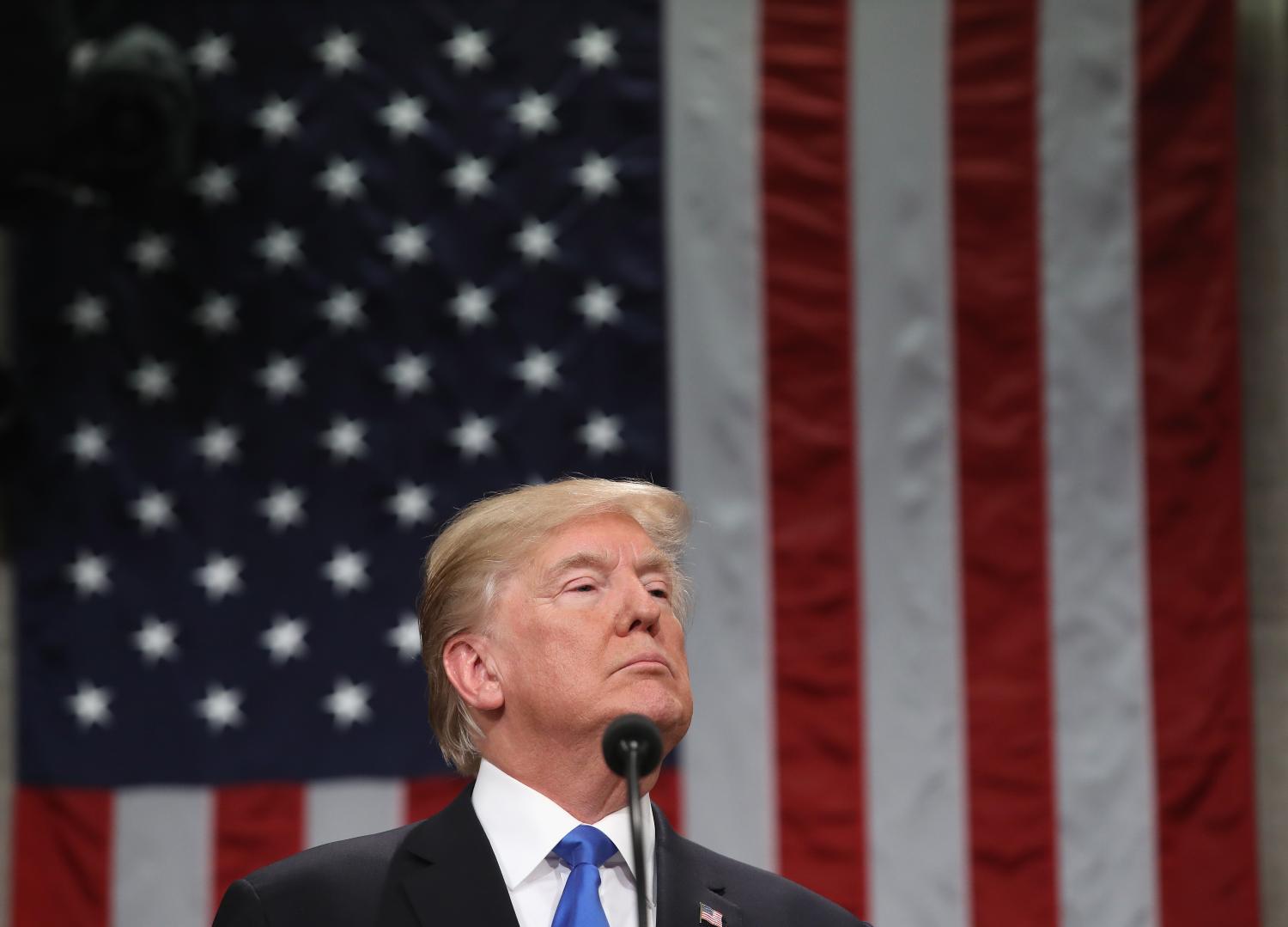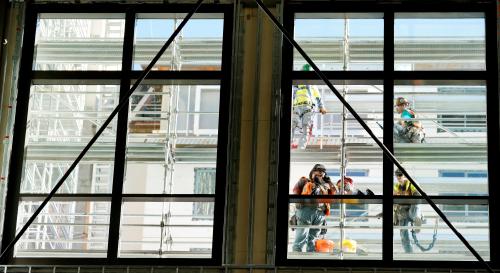President Trump and his economic team have made big promises about boosting future economic growth. Though official budget estimates assume growth will rise to 3 percent a year, the president suggests growth could be much faster. What policies have been implemented to justify these claims? The Administration has acted quickly on regulation, scaling back environmental rules and allowing more drilling. With new financial regulators in place, there has been some easing of bank rules, although no big changes. And, of course, just before the end of 2017, a tax bill was passed that lowered corporate taxes substantially and lowered individual taxes for some.
In 2017, the stock market was strong, employment gains were solid, and GDP growth was a bit faster than in the past few years at 2.5 percent. In 2018, so far, employment and GDP growth have continued to look solid, but the stock market has become very volatile, triggered by fears of inflation and higher interest rates. This is a good time to assess the Trump economic program and whether it will actually improve U.S. economic growth to the degree the president claims it will.
Help businesses grow profits, invest in the U.S., and create good jobs
The centerpiece of the administration’s growth program is the tax cut bill that reduced the corporate tax rate from 35 percent to 21 percent. On its face, a policy to reduce taxation of corporations is a solution in search of a problem. Corporate profits have been booming since the end of the recession and the share of profits in national income has risen. Not all companies and not all industries are doing well but, on average, U.S. corporations have lots of cash on-hand. If they want to expand and invest more, they have the resources to do it. Few companies paid the full amount of the statutory tax rate because of a variety of tax breaks put into the law over the years. The tax on corporate profits has been a smaller share of GDP in the U.S. than the average for OECD countries.
At the same time, the corporate income tax was full of distortions and had a marginal tax rate higher than most other advanced economies. There has been a case for corporate tax reform, which should mean eliminating deductions and tax breaks and using the revenue gained to lower the tax rate. That is hard to do politically because the companies that lose tax breaks fight to keep them. With some important exceptions, the administration’s tax bill took the easy way out, leaving most tax breaks unchanged and then cutting the statutory tax rate and reducing the taxation of foreign profits.
Estimates of the impact of the tax act on long run growth vary a lot, but analyses that look at the overall impact of all provisions have results that center around growth rate increases of 0.06 to 0.09 percent a year over a decade.1 The economic incentives built into the tax plan have a very small impact on growth, according to these estimates.
Perhaps the impact of the Trump policies are being understated by these technical analyses. Trump has been able to transform the mood of American business. Corporate leaders said Obama did not understand how business operates, blamed them for the economy’s problems and did not appreciate that they need to do well if the economy is to do well.
That optimism may be enough to kick off stronger investment and business expansion.
In meetings with business groups attended in recent years, I found the hostility towards the Obama administration startling. While many in the business community recognize problems with Trump, they see him as a fellow businessperson who is on their side and believe he will be able to spur faster growth. That optimism may be enough to kick off stronger investment and business expansion.
Reduce regulation to help small and large companies grow
Environmental and Energy Regulation. The regulatory environment in the U.S. has become very cumbersome. Multiple federal, state and local agencies may have to agree on permits and the legal system can drag out final approval for investments and expansions. The Obama Administration worked to streamline the approval process, but remained very supportive of cleaning up the environment.
The new administrator of the EPA is opposed to most regulations and argues that global warming may be a good thing.2 The administration is moving to eliminate restrictions on greenhouse gas emissions. EPA does not control state laws, but under the Trump regime it will be easier and cheaper for companies to resolve environmental concerns—at the price of more pollution.
This administration has opened up additional land for drilling and eliminated restrictions on the burning of coal. Are these changes going to solve a pressing problem in the economy? U.S. energy production has been soaring as a result of new technologies. Oil production is moving above 10 million barrels a day and natural gas is very cheap and abundant. Renewable energy sources have now become price competitive with fossil fuels. In the end, the deregulation of energy under this administration is symbolic and will have very little consequence for near term growth. Given this, it seems a mistake to abandon efforts to scale back harmful emissions.
Small Business Lending. Small and medium sized businesses were hit hard during the recession and were slow to recover. As the economy has strengthened, this sector of the economy is doing better, but is still behind. The number of startup companies has been in decline for decades and the reasons are not fully understood. In earlier decades, the decline simply reflected changing technology. Many new businesses were in retail or restaurants and the expansion of large retailers and chain restaurants drove out the small startups.
More recently, the decline has been in high-tech and high-growth entrepreneurial companies and the reason for that decline remains a puzzle.3 Since the Great Recession, a lack of financing may have contributed to the problem. Before the Great Recession, new companies could get started by using the equity in the homes of the founders. Home prices have recovered but there is still not the same ready supply of home equity and startups have to find other sources of cash. It was too easy to get a loan in the first years of this century, while today it may be too hard. Easing lending restrictions too much would increase the chances of another crisis, but that is unlikely to happen in the next few years. I would expect that general business optimism plus easier lending rules will help the small business community and add to economic growth, although not by a lot.
Trade and immigration restrictions
Unlike the tax bill, the Trump Administration’s policies on trade and immigration are a break with Republican tradition. Traditionally, Democrats have been much more ambivalent about trade agreements than Republicans because of the opposition of labor leaders, although in the end Democratic presidents have supported them. Like most economists, I support freer trade because it allows the United States to specialize in the parts of the economy where it is most productive. Some workers and companies are hurt by trade, but overall free trade is good for U.S. growth.
The restrictions on trade that Trump is proposing will raise costs to consumers, but they are unlikely to make a large difference. Despite his free market ideology, President Reagan imposed quotas on auto imports from Japan to protect the U.S. industry in the 1980s. Japanese companies responded by jumping over the barrier and bringing best-practice manufacturing facilities to the U.S. market. The trade barrier did not stop American consumers from buying Japanese cars. Today, companies that want to avoid the new tariffs on washing machines or solar panels can expand operations here. Trump is not motivated by trade theory, of course, but by the political advantage that comes from blaming trade for the decline in blue collar jobs. Trump’s trade policies may damage our trading partners, like Mexico or Canada, and they have undermined the standing of the U.S. in the world, but they will have little impact on U.S. growth either way. That said, China has a lot of economic weapons, and entering a trade war with China would be very damaging, indeed. Fortunately, the president seems to have walked back from such a conflict.
Immigration restrictions may have large effects. Trump proposes cutting legal immigration and closing the border in an effort to eliminate illegal immigration. The Pew Research Center estimates that the working age population in the United States will actually start to decline in the absence of immigrants,4 so there could be a significant decline in labor force growth and hence in the overall economic growth rate if there are drastic cuts in the number of immigrants.
Immigrants have been important in startup companies, especially technology companies. Silicon Valley was in part a creation of immigrants. Hostility towards immigrants will discourage smart and talented people from coming to the U.S. and undermine growth over the long run. It is hard to put a number on the impact, but it could be considerable.
Infrastructure
Trump campaigned on a pledge to introduce a large program of infrastructure investment. Specifics are now emerging and the proposed federal funding contribution is $200 billion over ten years. There is no question that America needs to upgrade its infrastructure. Roads, bridges, ports, the electricity grid, the water supply and other areas are in need of help. In the administration’s plan, the $200 billion would be leveraged into $1.5 trillion through private, state and local funding. The federal funds would be divided into $20 billion for projects of “national significance,” $50 billion for rural block grants and the rest would go for loan support or other likely high-leverage. The administration also wants to shorten the time for permitting and approvals.
It would certainly be helpful to speed up the permitting process and shorten litigation delays, but that will be tough to do, in practice, because many of the regulations are state laws.
And while taking $200 billion and multiplying it up to $1.5 trillion will be a pretty neat trick, it’s worth noting that the $200 billion is not a net addition to federal support. Some of that money is simply moved around from existing funding. It’s a stretch to think that the administration’s infrastructure initiative will have a significant positive impact on U.S. growth.
Barriers to faster growth: demand and supply
It is unusual to enact a large deficit-financed fiscal expansion when the economy is already at full-employment, but full employment does not mean the economy will hit a wall when it is given a demand boost. The fiscal stimulus will almost certainly increase growth in 2018 and 2019. There are advantages to a high-pressure economy where employers are fighting for workers and are even willing to hire unskilled workers and train them. Workers did well in the high-pressure economy of the late 1960s and again in the late 1990s.
The snag, of course, is that a high pressure economy may turn into an inflationary economy and the Federal Reserve is charged with barring the door against that possibility. Following the tight economy of the 1960s there was an inflation problem that lasted for 15 years. Following the tight economy of the 1990s, though, there has been no inflation problem, in fact the Federal Reserve has had trouble getting inflation up to its target of 2 percent. Monetarist economists who predicted runaway inflation from the Federal Reserve’s quantitative easing policy have fallen on their faces as inflation has stayed low or even fallen. Believers in the Phillips curve tradeoff between inflation and unemployment have done better, but not much better.
At times recently it has seemed that the determinants of inflation are a mystery—but really they are not a complete mystery. The rise of China and the Asian supply chain held down prices of manufactured goods. The expansion of the supply of commodities has eased pressure on the prices of oil, metals and food. Prolonged recession in Europe and Japan and slowing growth in China eased demand globally. But these forces have run their course or are no longer powerful enough to offset a global economy that is now growing faster and a U.S. economy that may be busting through its full employment benchmark. The Federal Reserve is already moving expeditiously to raise rates, and if inflation picks up they will accelerate the pace. The current stock market volatility started because investors were suddenly spooked about inflation and the Federal Reserve’s response. Rising interest rates will likely put a brake on U.S. growth.
If there is a limit to how much more growth can be obtained with demand expansion, that leaves supply growth as the main possibility. Supply-side growth is deflationary. The Federal Reserve would be willing to accommodate faster growth if it came from either a more rapid increase in the labor force or faster productivity growth.
Getting much help from faster labor force growth is a non-starter. Labor force participation has been declining for years as a result of an aging population and the lack of good jobs. If the fiscal stimulus leads to a high-pressure economy and that opens up better jobs, there could be some improvement in labor supply. However, whatever is achieved in higher–than-expected labor supply among native-born women and men will be offset by the restrictions this administration is placing on immigrants. If there are sharp immigration cuts, we will not achieve the 0.5 percent a year growth in the workforce that is currently predicted by the Congressional Budget Office.
Productivity is much more of a wild card and very tough to predict. GDP per worker grew at around 2.3 percent a year from 1950 through the early 1970s. It grew at 1.3 percent until the mid-1990s, when it resumed rapid growth again, at 2.8 percent a year, until 2004. Then it slowed down to under 1.1 percent a year. Slow productivity growth is the biggest reason GDP has grown so slowly since 2004.5
Since productivity growth has had such an erratic pattern, it is hard to argue that it can’t or won’t speed up again. Suppose, by some miracle, GDP per worker growth were to return to the rate of 2.8 percent achieved from 1995 to 2004. Add in 0.5 percent a year growth in the workforce and GDP growth would then be 3.3 percent a year, achieving the administration’s estimates. On the other hand, suppose productivity growth does not increase, staying instead at the same pace it has had from 2004 through 2017. This would put long run GDP growth at 1.6 percent a year. If immigration restrictions drop the growth in the labor force down below 0.5 percent, then the lower bound for GDP growth is even lower, perhaps 1.3 percent. That is a big range of possible values and where the economy comes out will make a big difference to the growth of American living standards, and to the fortunes of this administration.
The trouble with predicting a return to much stronger growth is that none of the policy measures being introduced can be expected to yield the super rapid productivity growth achieved in the 1990s. There might be a lucky break and it would happen, but it is a very long shot. In making their forecasts, the Congressional Budget Office averages the period of rapid growth with the much slower growth since 2004 and estimates the long run sustainable growth rate of the economy is 1.9 percent per year. That number is actually fairly optimistic. It does not assume significant reductions in the number of immigrants and it does assume growth of GDP per worker that is 0.3 percent faster than the rate since 2004. One could score that figure as a success for Trump growth policies, except that his ambitions are so much greater.
The deficit
There are voices crying in the wilderness about the problem of the budget deficit and these voices have not got any traction. They are going to get louder. Annual federal deficits are expected to exceed a trillion dollars a year and the debt to GDP ratio is headed quickly for 100 percent. Will debt and deficits derail economic growth? The reason deficit warnings have not been heeded so far is that voters do not see adverse effects. Americans are able to make use of federal services, such as Social Security and Medicare, while taxpayers provide much less than the full cost of these programs. Those who worry about deficits argue, correctly, that our children and grandchildren will have to service the debt so we are passing our deficit spending on to them. However, as long as interest rates remained low that burden has not seemed too bad. Americans have financed budget deficits by borrowing from the rest of the world, but are borrowing at such low rates that it looks like a great deal.
Looking forward, the deficit problem may be catching up with us. As the debt to GDP ratio moves to 100 percent, that means each percentage point of interest on the debt has to be paid for by 1 percentage point of GDP in taxes or in additional borrowing. The Federal Reserve is already pushing up rates at the short end of the yield curve and with the projected level of Treasury borrowing, long rates are bound to rise too. If the holders of US Treasury securities, including a lot of foreigners and foreign governments, decide US debt is risky, they will start demanding a risk premium on Treasuries. As interest rates rise, that puts a damper on US investment. The cut in corporate taxes has given a boost to investment, but that could be reversed by rising interest rates.
Looking forward, the deficit problem may be catching up with us.
There is one part of the economy that is already feeling the effect of the budget deficits: the part exposed to foreign trade, particularly manufacturing. Borrowing from abroad constitutes an inflow of financial capital that pushes up the value of the dollar, making U.S. goods and services more expensive and imports cheaper. Large and persistent U.S. trade deficits started in the 1980s when big federal deficits first began. There is not a direct year-to-year connection between the budget deficit and the trade deficit because other factors can impact both of them. A recession increases the budget deficit and reduces the trade deficit, as happened in the Great Recession.
However, the connection between the budget deficit and the trade deficit does exist so that increases in the budget deficit will spill over into higher trade deficits in a full employment economy. That creates an irony for Trump’s policies. He has pledged to fight trade deficits by imposing trade restrictions, but these will be ineffective. Imposing trade barriers on Mexico, for example, will just shift U.S. imports to other products or other countries. In the meantime, the tax bill will push up the budget deficit and worsen the overall trade deficit.
Improving business sentiment versus unrealistic expectations
The most effective policy Trump has introduced to spur growth is to energize business leaders, making them more willing to invest and expand. The tax cut reinforces this by putting more money into the hands of companies and households and making the U.S. a more attractive place to invest.
But Trump has also introduced policies with a negative impact on growth, notably the restrictions on immigration and increases in the federal deficit. Trump seems incapable of any restraint in his claims of success and he talks about future growth rates that are very unlikely to occur. Over-promising and under-delivering is a dangerous game that can lead to disillusion and could undermine the optimism of business leaders. Perhaps the GDP statistics will soon be considered fake facts.
-
Footnotes
- These are estimates based on the impact of higher investment on labor productivity. The demand impact of the fiscal expansion are different. See Macroeconomic Advisers, “The Macroeconomic Impact of the Tax Cuts and Jobs Act,” February 6, 2018. See a listing of several estimates on slide 4 of Jason Furman, “Some Preliminary Macroeconomics of the Tax Cuts and Jobs Act,“ Harvard Kennedy School, January 6, 2018.
- https://www.cnn.com/2018/02/08/politics/scott-pruitt-climate-change/index.html
- Jay Shambaugh, Ryan Nunn and Patrick Liu, Hamilton Project Report, February 2018, http://www.hamiltonproject.org/assets/files/how_declining_dynamism_affects_wages.pdf
- See Pew Research Center, “Immigration Projected to drive growth in US working age population through at least 2035, March 8, 2017, http://www.pewresearch.org/fact-tank/2017/03/08/immigration-projected-to-drive-growth-in-u-s-working-age-population-through-at-least-2035/
- From the Conference Board, Total Economy Database, TCB adjusted data



